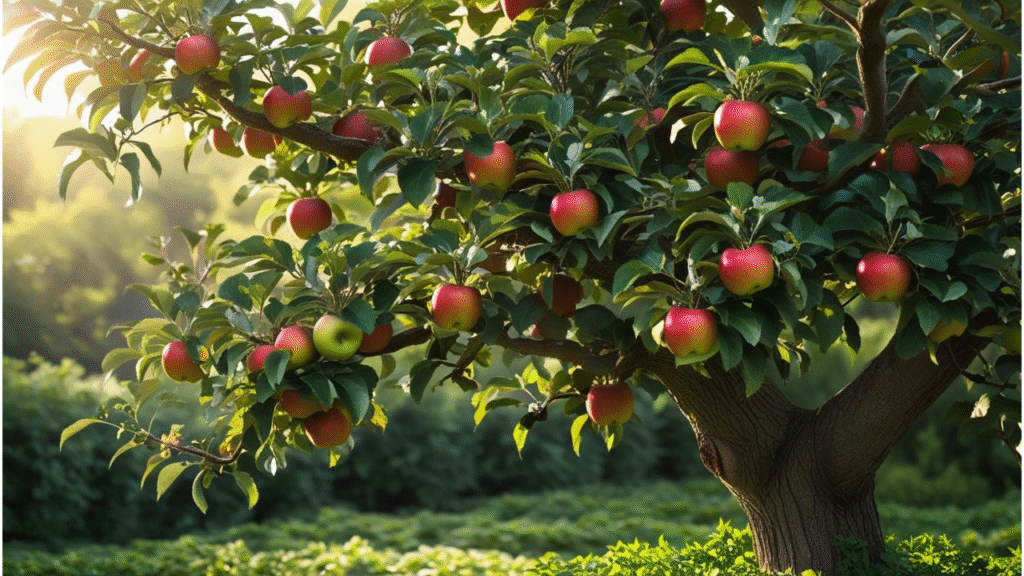
How Long Does It Take for Apple Trees to Grow? A Complete Guide to Fast and Healthy Growth
Have you ever wondered how long does it take for apple trees to grow and bear fruit? 🍏 If you’re dreaming of homegrown apples but aren’t sure when to expect your first harvest, you’re not alone. The journey from planting a tiny sapling to enjoying the sweet fruits of your labor can feel like a waiting game, but with the right knowledge and care, you can set your apple trees up for success. 🌳
In this guide, we’ll break down everything you need to know about apple tree growth, including key factors that influence the process and practical tips for speeding it up. Whether you’re a first-time gardener or an experienced grower, understanding the growth timeline and the steps involved will help you grow strong, healthy apple trees that thrive year after year.
Ready to plant your apple orchard and see it flourish? Keep reading to discover the secrets to fast and healthy apple tree growth!
Table of Contents
Toggle🏡🌳 How Long Does It Take for Apple Trees to Grow? 🌳🏡
If you’ve just planted an apple tree 🌳 or are planning to, you’re probably wondering how long it takes ⏳ for apple trees to grow 🌱 and bear fruit 🍏. The answer varies depending on a few factors, but don’t worry – we’ll break it down for you! 😊
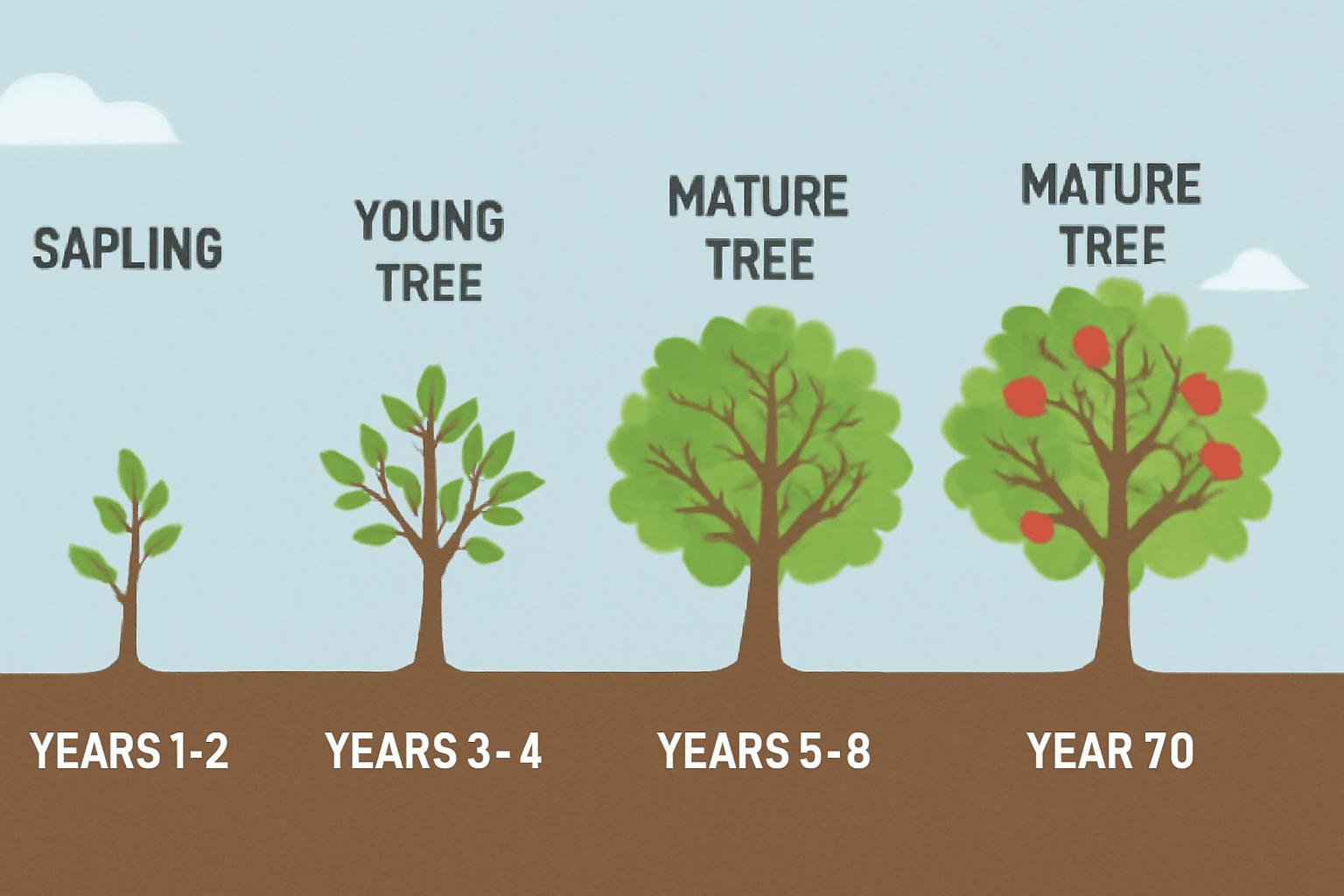
🌱 Growth Timeline for Apple Trees 🌱
On average, apple trees 🌳 take about 3 to 5 years 🗓️ to start producing fruit 🍏 if you’ve planted a dwarf variety. Standard apple trees 🌳 can take 5 to 7 years, while some varieties 🍏 can take up to 10 years for full maturity. 📅
But don’t be discouraged – during this time, your tree 🌳 will go through some important growth stages 🌱. Let’s take a look at them:
🌿 Growth Stages of an Apple Tree 🌿
Germination (Year 1) 🌱
The first year 🌱 is all about the roots 🌿 getting established and the tree 🌳 beginning its slow but steady growth 📈.
Young Tree Stage (Years 1–3) 🌳
In this phase 🐣, the apple tree 🌳 focuses on growing leaves 🍃, branches 🌿, and roots 🌱 – it’s still too early for fruit 🍏, but it’s building its foundation 💪.
Mature Tree (Years 4–6) 🌳
This is when you’ll start to see your tree 🌳 bloom 🌸! Depending on the variety 🍏, small fruits 🍏 might start to form, though it’s still a trial run 🤔.
Full Maturity (Years 6–10) 🌳
By now, your tree 🌳 should be producing a healthy amount of apples 🍏 annually, with bigger, juicier fruits 🍏 ready for harvesting! 🍏
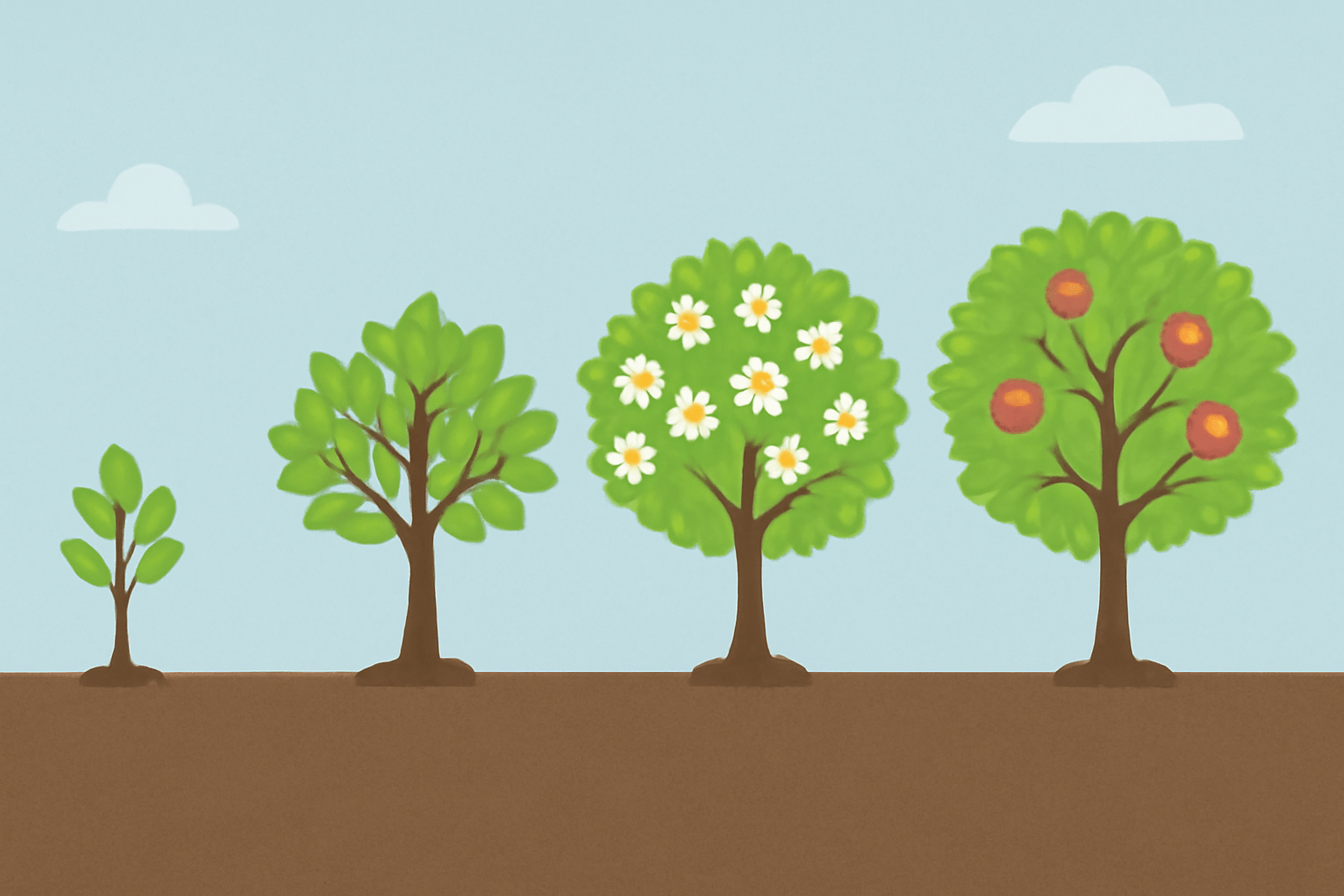
🐝 Factors That Affect Growth Speed 🌱
Several things can affect how long your apple tree 🌳 takes to grow 🌱, including:
- Tree Variety 🌳: Dwarf trees 🌿 grow faster ⚡ and start bearing fruit 🍏 earlier than standard-sized varieties 🌳.
- Climate 🌞❄️: Apple trees 🌳 thrive in temperate climates 🌤️ with cold winters ❄️ and moderate summers 🌞. Too much heat 🌞 or frost ❄️ can slow down their growth ⏳.
- Soil Quality 🌱: Healthy, well-drained soil 🌍 gives your tree 🌳 the nutrients it needs to grow quickly ⚡ and strong 💪.
- Care and Maintenance 🌿: Regular watering 💧, pruning ✂️, and pest management 🐜 help the tree 🌳 stay healthy and grow efficiently 🌿.

🌞 The Bottom Line 🌞
So, how long does it really take ⏳ for apple trees 🌳 to grow 🍏? While you can expect some varieties 🍏 to produce fruit 🍏 in as little as 3–5 years, your apple tree 🌳’s growth will depend on the type 🍏 you’ve chosen and the care 💚 it receives. Stay patient 🕰️ and keep your tree 🌳 healthy 💪, and you’ll be rewarded with homegrown apples 🍏 before you know it! 🌳🍏
🌳🌱 Key Factors That Influence Apple Tree Growth 🌱🌳
Apple tree growth 🌳 doesn’t just depend on planting it in the ground 🌍 and waiting ⏳. Several important factors can speed up ⚡ or slow down ⏱️ the process. Let’s dive into the key elements that influence how quickly your apple tree 🌳 grows, and how you can optimize each one for the best results. 😊
🌞 1. Tree Variety and Rootstock 🌳
The variety of apple tree 🌳 you choose will have a significant impact on its growth speed ⏩.
- Dwarf Apple Trees 🌱: These trees 🌳 are smaller and grow much faster ⚡ than standard varieties. They typically bear fruit 🍏 in 3–5 years. If you’re looking for quick results, dwarf varieties 🌱 are your best bet.
- Standard Apple Trees 🌳: Larger and slower-growing 🐢, these trees take 5–7 years to mature and start producing fruit 🍏. However, they tend to be hardier 💪 and may live longer 🌳 than dwarf trees 🌱.
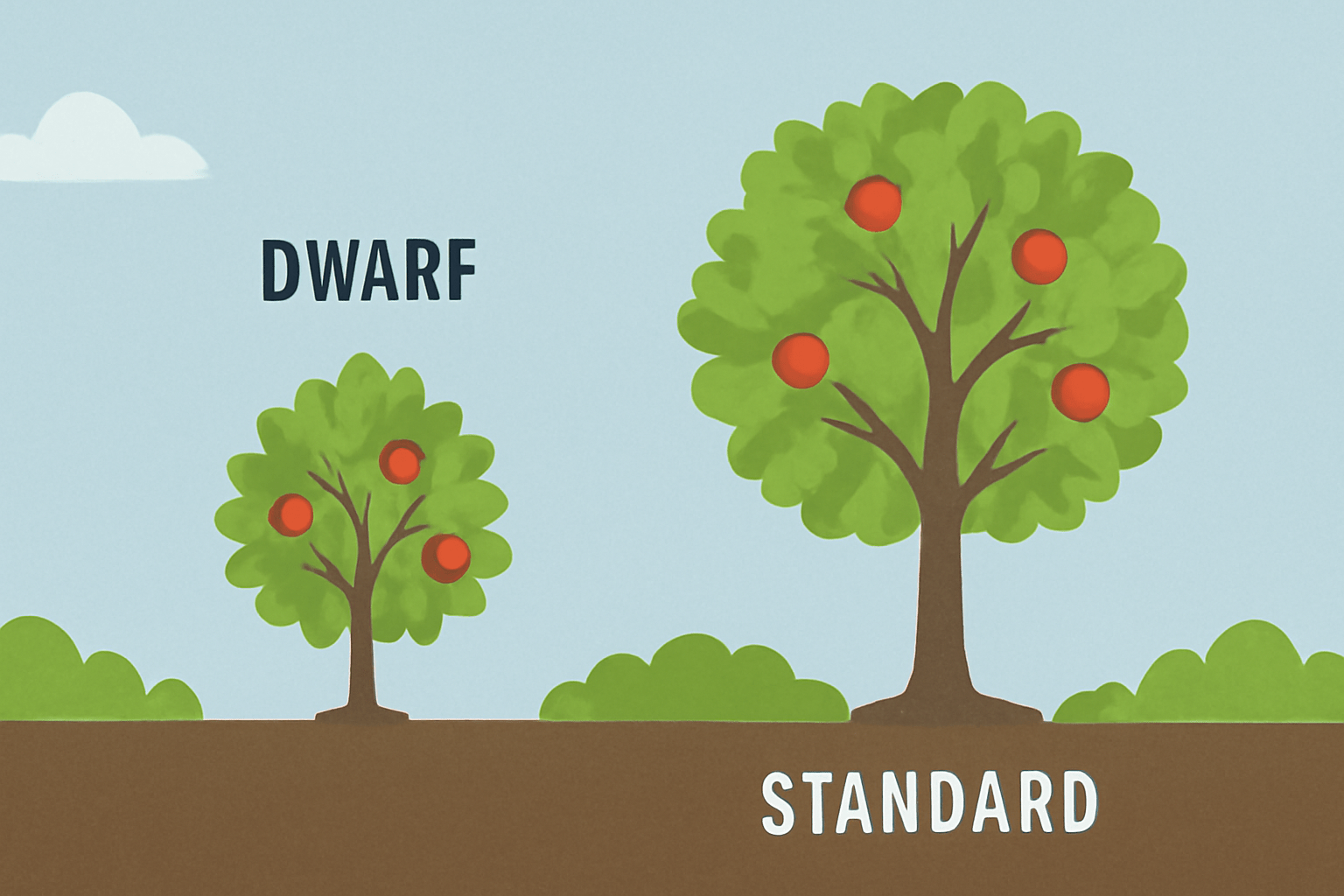
Rootstock 🌳: Apple trees 🌳 are often grafted onto rootstocks, which affect their size 📏 and growth rate ⏩. Rootstocks like M27 or M9 are commonly used for dwarf trees 🌱, while MM106 and M26 support semi-dwarf and standard trees 🌳. The type of rootstock determines how quickly the tree 🌳 grows and bears fruit 🍏.
🌡️ 2. Climate and Weather Conditions 🌤️
Apple trees 🌳 thrive in temperate climates 🌍, but extreme weather 🌪️ can slow down ⏳ or damage their growth 🌱.
- Ideal Temperature 🌞: Apple trees 🌳 prefer cool winters ❄️ and moderate summers 🌞. They need a certain amount of chill hours (cold temperatures) ❄️ in winter to stimulate proper growth 🌱 and fruiting 🍏.
- Frost ❄️: Late spring frosts 🌨️ can damage blossoms 🌸 and stunt growth 🐢. Planting in a location 🏡 that’s less prone to frost ❄️ will help your tree 🌳 thrive.
- Rainfall 🌧️: Apple trees 🌳 need consistent moisture 💧, but they don’t like “wet feet” 🦶. Too much water 🌊 can lead to root rot 🦠, while too little can stunt growth 🌱. Make sure to keep the soil moist 💦 but well-drained 🌿.

🌍 3. Soil Quality and Nutrients 🌱
The soil 🌍 you plant your apple tree 🌳 in is critical ⚡ to its growth 🌱.
- Well-Drained Soil 🌿: Apple trees 🌳 need soil 🌱 that drains well to prevent waterlogging 💦, which can harm the roots 🌱. Loamy, slightly acidic soil 🧪 with a pH of 6–7 is ideal 👍.
- Nutrients 🧪: Fertilizing 🧑🌾 your tree 🌳 can give it the boost it needs. Use a balanced fertilizer 🌱 during the growing season 🌞 to promote healthy leaf 🍃 and fruit 🍏 development. A good mix of nitrogen 🟢, phosphorus 🟣, and potassium 🔴 will help your tree 🌳 grow strong 💪.
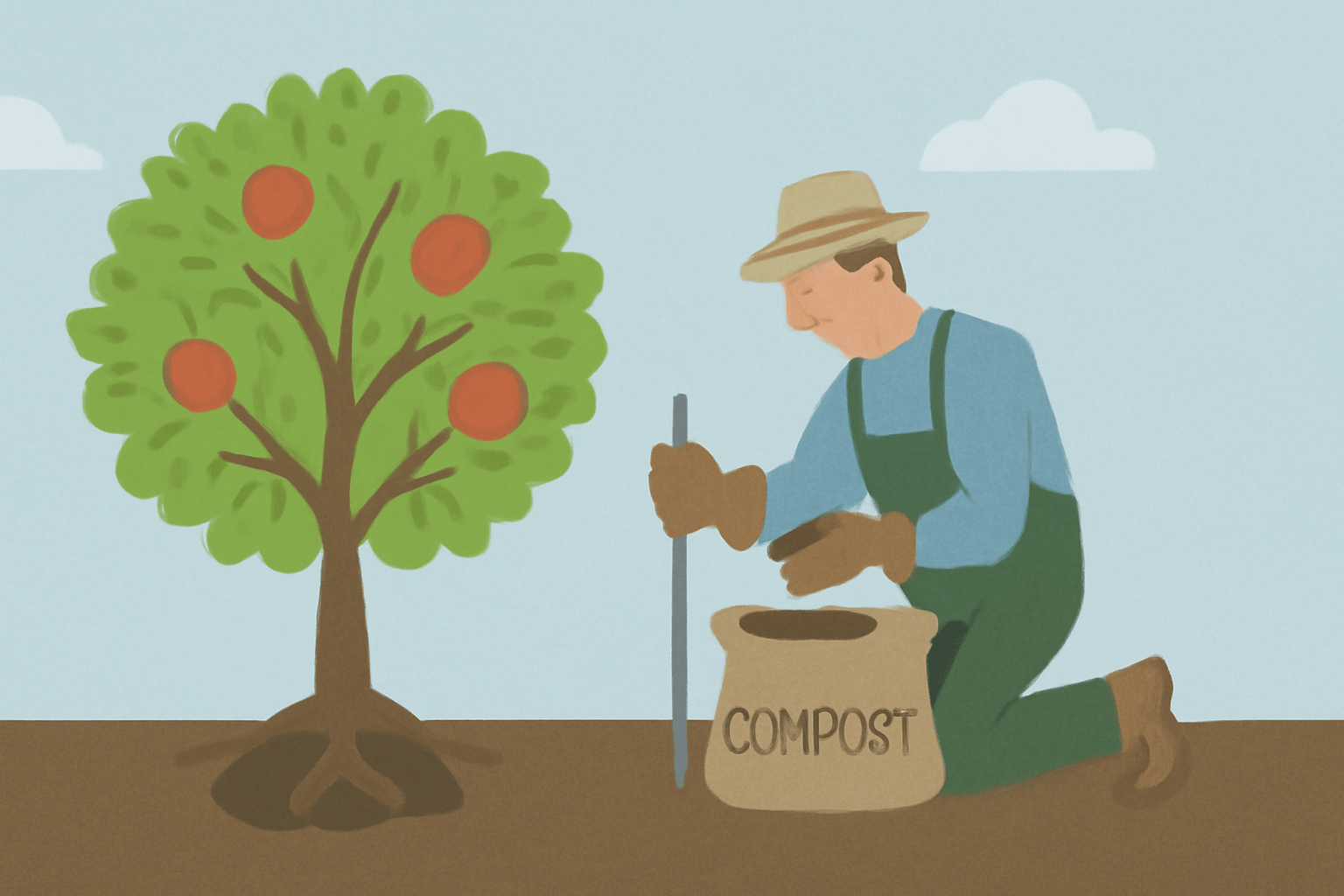
💧 4. Watering and Irrigation 💦
Water 💧 is essential for healthy apple tree growth 🌳, but it’s a balance ⚖️!
- Deep Watering 💦: Apple trees 🌳 prefer deep watering 💧 rather than shallow, frequent watering 🚰. This encourages roots 🌱 to grow deep into the soil 🌍, which makes the tree 🌳 more drought-resistant 💧.
- Avoid Overwatering 💧: While apple trees 🌳 need regular water 💦, overwatering can lead to root rot 🦠 and fungal diseases 🍄. Always ensure your tree 🌳 has well-drained soil 🌿 to keep the roots 🌱 happy and healthy.
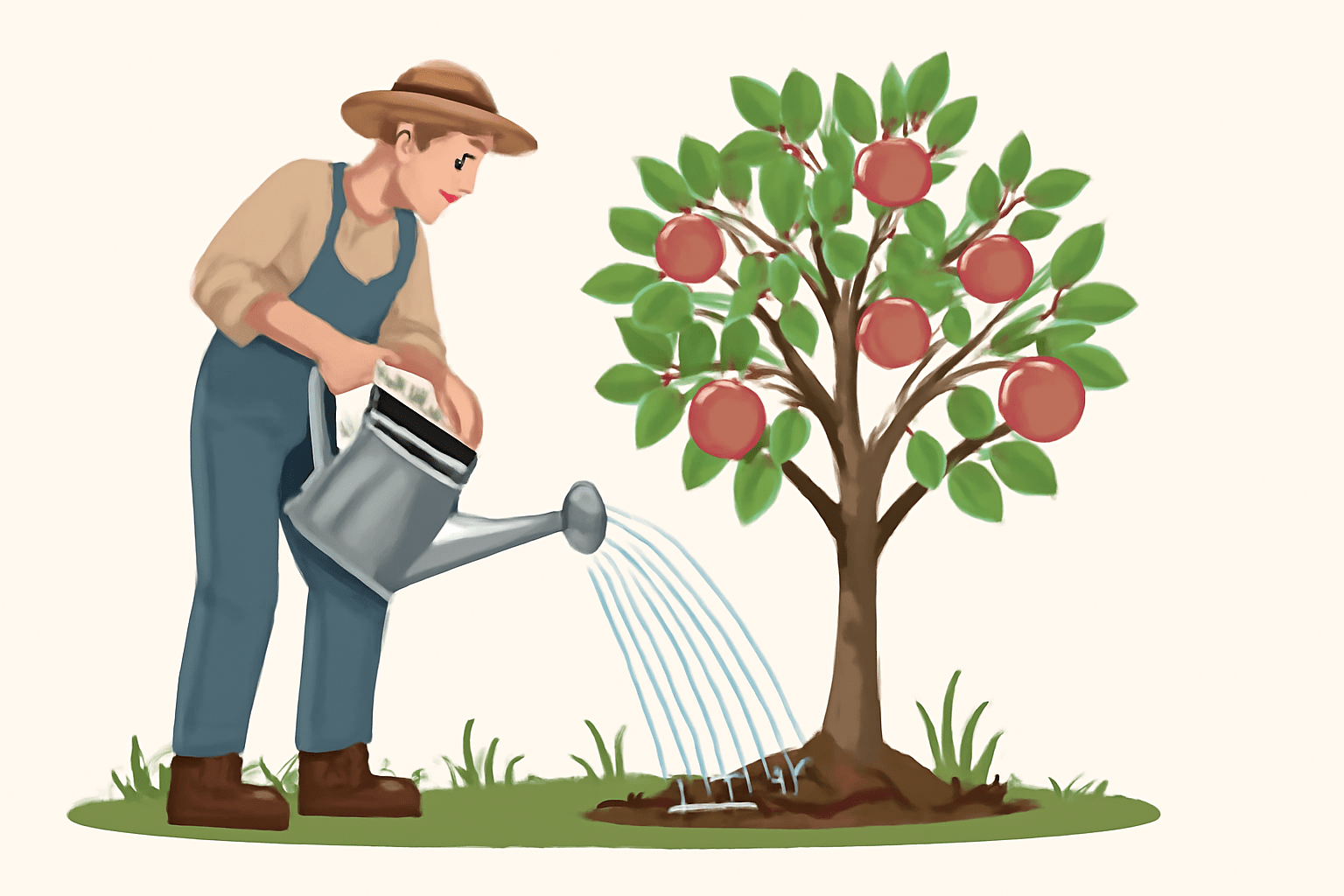
✂️ 5. Pruning and Maintenance ✂️
Pruning ✂️ helps apple trees 🌳 grow faster ⚡ and healthier by promoting better airflow 💨, sunlight exposure ☀️, and stronger branch development 🌿.
- Annual Pruning ✂️: Regular pruning ✂️ removes dead ❌ or diseased branches 🌳, allowing the tree 🌳 to focus its energy 💪 on growing stronger 💪, healthier parts 🌱. This also improves air circulation 💨 and light penetration 🌞.
- Thinning Fruit 🍏: In the early years 🌱, thin out excess fruit 🍏 to allow the remaining apples 🍏 to grow larger. This will also help the tree 🌳 focus on growing strong 💪 rather than being overburdened 😓 with too many fruits 🍏.
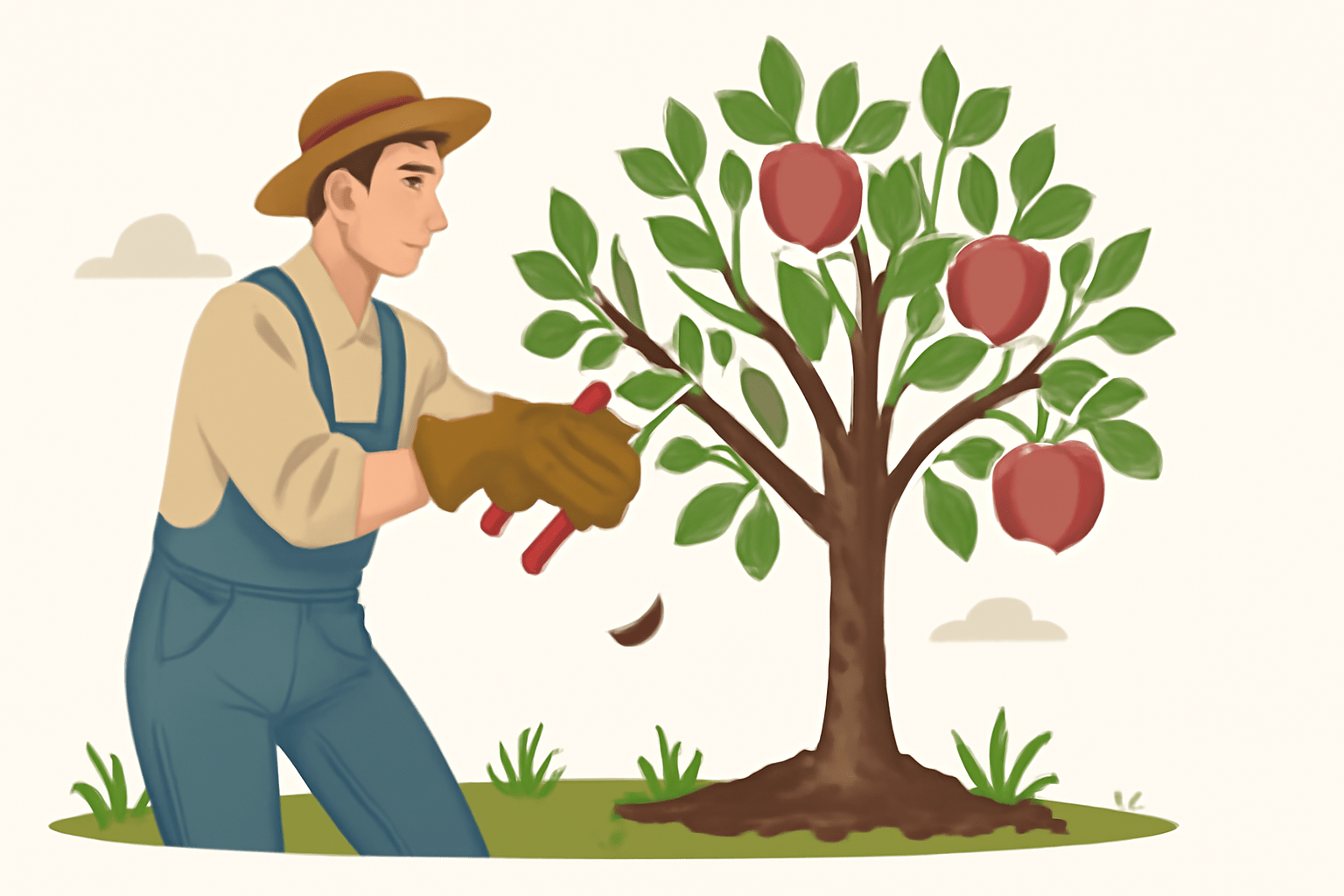
🐞 6. Pest and Disease Management 🦠
Healthy apple trees 🌳 are better at growing 🌱 and producing fruit 🍏, so protecting them from pests 🐜 and diseases 🦠 is essential 🛡️.
- Common Pests 🐜: Aphids 🐞, apple maggots 🐛, and codling moths 🦋 are a few of the common pests 🐜 that can slow down apple tree 🌳 growth 🌱. Regular monitoring 👀 and pest control measures, like neem oil 🌿 or organic pesticides 🧪, can keep these problems in check ✅.
- Diseases 🍄: Apple trees 🌳 can fall victim to diseases 🍂 like apple scab 🍏 and powdery mildew 🍄. Applying fungicides 🍄 during the growing season 🌞 and practicing good garden hygiene 🧑🌾 (removing fallen leaves 🍂, for example) can help prevent these issues.
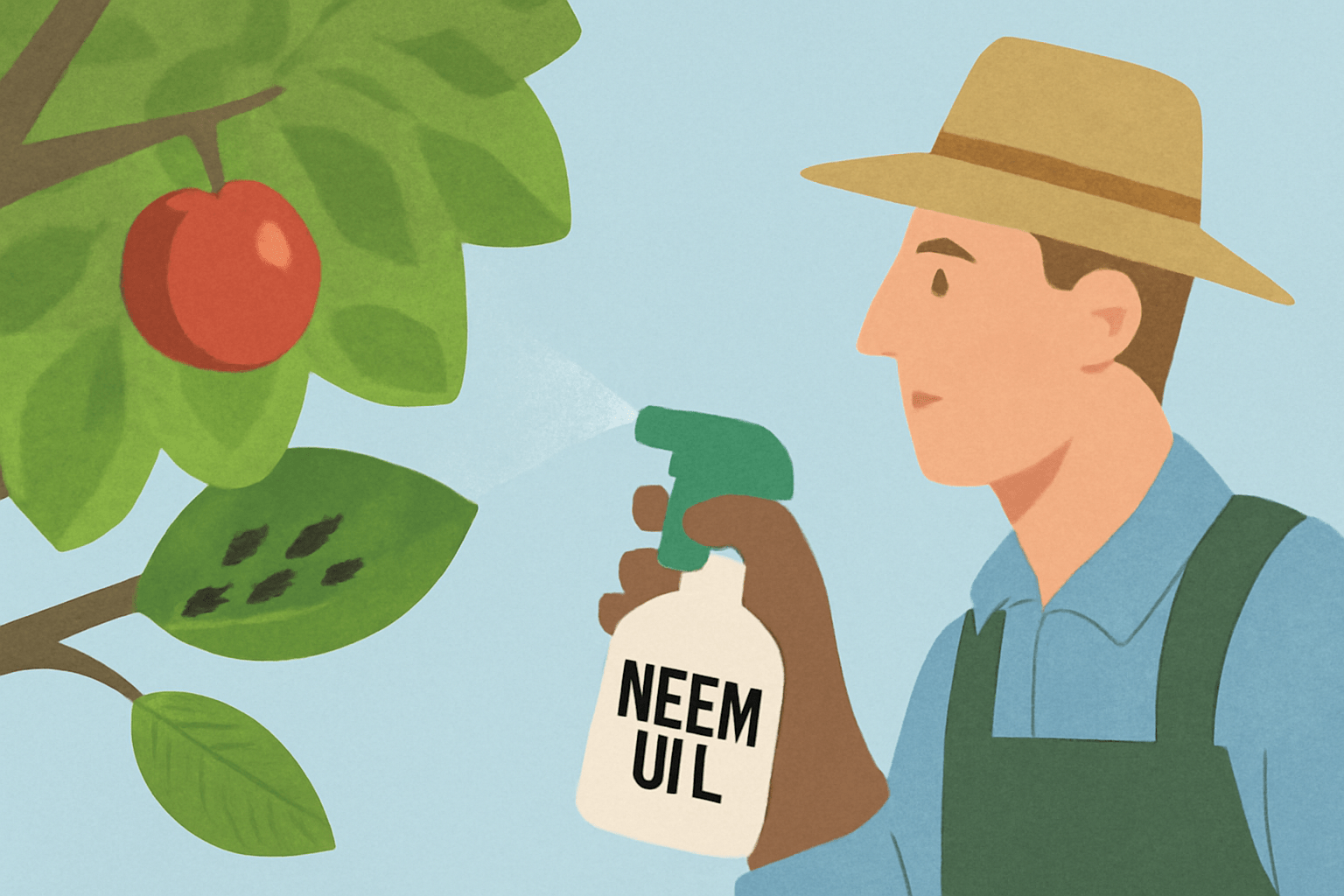
🌿 The Bottom Line 🌿
By taking care of these key factors 🔑—choosing the right variety 🌳, providing optimal climate 🌞 and soil conditions 🌿, maintaining proper watering 💧, and staying on top of pruning ✂️ and pest management 🐜—you can help your apple tree 🌳 grow quickly ⚡ and healthily 🌱. With the right care 🧑🌾, your apple tree 🌳 will be well on its way to producing beautiful 🍏, delicious fruit 🍏 in no time ⏳! 🌳🍏
🍏🌱 Tips for Fast and Healthy Apple Tree Growth 🌱🍏
If you’re eager to see your apple tree 🌳 grow strong 💪 and start bearing fruit 🍏 quickly, there are several strategies you can implement. By following these simple, practical tips, you can ensure that your apple tree 🌳 grows faster ⚡, healthier 🌱, and more robust 💪. Let’s dive into the best practices for optimizing apple tree growth! 😊

🌞 1. Proper Planting Techniques 🌳
The foundation 🏗️ of a healthy apple tree 🌳 starts with the right planting techniques 🌱. Getting this step right is crucial for encouraging fast growth ⚡.
- Choose the Right Location 🌞: Apple trees 🌳 love sunlight ☀️! Plant your tree 🌳 in a location 🏡 that receives at least 6–8 hours of direct sunlight 🌞 each day. This ensures proper photosynthesis 🌿 and strong growth 💪.
- Space Properly 🌿: Make sure to space apple trees 🌳 about 10–15 feet apart to avoid overcrowding 🚫. This allows the tree 🌳 to grow with enough airflow 💨 and access to nutrients 🧪.
- Plant at the Right Depth 🌱: Dig a hole 🕳️ wide enough to accommodate the roots 🌱 and plant the tree 🌳 at the same depth it was in its pot 🪴. Avoid planting too deep, as this can suffocate the roots 🌱 and stunt growth 🐢.
💧 2. Consistent Watering 💦
Watering 💧 is key to promoting healthy growth 🌱, but it needs to be done the right way 💧.
- Deep Watering 🌊: Water 💧 your apple tree 🌳 deeply, especially during dry spells 🌞. Shallow watering 🚰 encourages weak, surface-level roots 🌱. Aim for deep watering once a week 🗓️ during dry periods, ensuring the water 💦 reaches the root zone 🌱.
- Mulch for Moisture 🌾: Add a layer of organic mulch 🍂 around the base of the tree 🌳 to help retain moisture 💧, prevent weed growth 🌱, and regulate soil temperature 🌡️. This will also protect the roots 🌱 from extreme heat 🌞 and cold ❄️.
✂️ 3. Pruning and Shaping ✂️
Regular pruning ✂️ not only keeps your tree 🌳 looking neat but also promotes healthier growth 🌱 and better fruit 🍏 production.
- Annual Pruning ✂️: Prune ✂️ your apple tree 🌳 every year 🗓️, ideally during late winter ❄️ or early spring 🌸 before the growing season 🌱 begins. Remove any dead ❌, diseased 🦠, or damaged branches 🌳 to improve airflow 💨 and sunlight exposure ☀️.
- Thin Out Excess Fruit 🍏: In the early years 🌱, it’s helpful to remove some of the smaller fruit 🍏 to allow the remaining ones to grow bigger and healthier 🌱. Thinning fruit 🍏 also reduces the strain on the tree 🌳, promoting better overall growth 🌱.
🐝 4. Pollination Tips 🌸
Apple trees 🌳 often require cross-pollination 🐝 to produce fruit 🍏. Ensuring that your tree 🌳 is properly pollinated 🐝 can speed up fruiting 🍏.
- Plant Compatible Trees 🌳: To ensure good pollination 🌸, plant at least two compatible apple tree 🌳 varieties nearby. Bees 🐝 and other pollinators 🦋 will do the work of transferring pollen 🌸 between flowers 🌸.
- Bees Matter 🐝: Encourage pollinators 🐝 to visit your tree 🌳 by planting flowers 🌸 that attract bees 🐝 around your apple tree 🌳. Healthy pollinators 🐝 lead to healthier and faster fruit production 🍏.
🌿 5. Fertilization and Soil Care 🌱
Apple trees 🌳 need the right nutrients 🧪 to grow strong 💪 and bear fruit 🍏.
- Balanced Fertilization 🌾: Apply a balanced, slow-release fertilizer 🧪 in early spring 🌷 to provide the necessary nutrients 🧪. Look for fertilizers 🧴 with equal parts nitrogen 🟢, phosphorus 🟣, and potassium 🔴 (NPK).
- Soil Testing 🌍: Test your soil 🌱 regularly to ensure that it’s rich in nutrients 🧪. Add organic matter 🍂, compost 🌾, or well-rotted manure 🐄 to improve soil quality 🌱 and help your tree 🌳 grow stronger 💪.
🌿 6. Pest and Disease Prevention 🐜
Healthy trees 🌳 grow better! Keep pests 🐜 and diseases 🦠 at bay to ensure fast growth 🌱.
- Early Detection 👀: Regularly inspect your apple tree 🌳 for signs of pests 🐜, such as discolored leaves 🍃 or damaged fruit 🍏. The earlier you spot a problem 🐛, the easier it will be to manage 🛠️.
- Natural Remedies 🌿: If you prefer an eco-friendly ♻️ approach, try organic pest control methods 🌱 such as neem oil 🌿, insecticidal soap 🧼, or diatomaceous earth 🐚 to keep harmful pests 🐜 in check.
- Fungicide for Prevention 🍂: Apply fungicides 🍄 as a preventive measure, especially in spring 🌸, to protect against diseases 🦠 like apple scab 🍏 and powdery mildew 🍄.
🛡️ 7. Protect Against Extreme Weather 🌞❄️
Apple trees 🌳 can be sensitive to both cold ❄️ and heat 🌞, so taking steps to protect them from extreme weather 🌀 can help them grow better 🌱.
- Winter Protection ❄️: Use tree wraps 🌲 to protect young apple trees 🌳 from frost damage during the winter 🌨️. You can also add mulch 🍂 around the base to insulate the roots 🌱.
- Summer Heat 🌞: In areas with intense summer heat 🌞, provide some shade 🌳 during the hottest parts of the day 🌞 using shade cloth 🏖️ to prevent sunburn 🌞 and keep the tree 🌳 hydrated 💧.
🌟 The Bottom Line 🌟
By following these simple, yet effective tips 🌱—proper planting 🌱, consistent watering 💧, annual pruning ✂️, and good pest management 🐜—you can promote faster ⚡ and healthier growth 🌱 for your apple tree 🌳. With the right care 🧑🌾, your tree 🌳 will grow strong 💪 and eventually reward you with a bountiful harvest 🍏 of delicious apples 🍏! Patience ⏳ and attention to detail 💖 go a long way in achieving the best results, so start applying these tips 🌱 and watch your apple tree 🌳 thrive! 🌿
🍏🌿 What to Expect During the Growing Process 🌿🍏
Growing an apple tree 🌳 is an exciting journey 🚀, and understanding what to expect during each phase 🗓️ can help you stay patient 🕰️ and provide the right care 💚. Whether you’re planting a new tree 🌱 or caring for one that’s already established 🌳, knowing what’s ahead ensures a healthy 🌱, productive tree 🍏. Let’s break down the key milestones 🗓️ and what to expect during your apple tree 🌳’s growth process! 😊

🌱 1. Early Years (Year 1–3) 🌱
The first few years 🌱 are all about establishing the tree 🌳’s foundation 💪. During this period 🕒, your apple tree 🌳 will focus on growing roots 🌱, stems 🌿, and leaves 🍃, rather than fruit 🍏. Here’s what you can expect 👀:
- Growth Focus 🌱: In the first year 🌱, the tree 🌳 will be busy developing its root system 🌱 to anchor itself into the ground 🌍 and begin absorbing nutrients 🧪. You may notice small branches 🌿 and leaves 🍃 emerging, but it won’t yet have flowers 🌸 or fruit 🍏.
- Small Growth Spurts 🌿: In Year 2 and Year 3 🌱, your tree 🌳 will gradually grow taller 📏 and begin producing more branches 🌳. This is when it builds its overall structure 🏗️ and prepares for future fruiting 🍏. At this stage 🐣, don’t expect to see fruit 🍏 just yet, but your tree 🌳 should be growing steadily 🌱.
Care Tips 🌾: Focus on proper watering 💧, nutrient-rich soil 🧪, and early pruning ✂️. Keep an eye 👀 out for pests 🐜 or diseases 🦠, and protect the tree 🌳 from frost ❄️ in the colder months.
🌸 2. Flowering and Fruit Production (Year 4–6) 🌸
This is when the excitement begins 🎉! After several years of growth 🌱, your apple tree 🌳 will start to bloom 🌸 and produce its first fruits 🍏.
- First Blossoms 🌸: By Year 4, many apple trees 🌳 will begin to produce their first flowers 🌸. These blossoms 🌸 are essential for pollination 🐝, which leads to fruit production 🍏. Keep an eye on the weather 🌦️ to prevent damage from late frosts 🌨️.
- Early Fruit Formation 🍏: By Year 5, small apples 🍏 may begin to form. However, don’t expect a large harvest 🍏 yet! The tree 🌳 will likely have small or fewer fruits 🍏 during its first few fruiting years.
Pollination 🐝: Ensure you have cross-pollinating apple tree 🌳 varieties nearby 🌳 to support fruit formation 🍏. Bees 🐝 and other pollinators 🦋 are essential during this phase 🐝.
Care Tips 🌿: You can thin out excess fruit 🍏 to encourage bigger apples 🍏 and prevent your tree 🌳 from becoming overwhelmed 😓. Continue with regular watering 💧, feeding 🧪, and pruning ✂️ to support healthy growth 🌱.
🌳 3. Full Maturity and Consistent Harvest (Year 6–10) 🌳
After a few years of growth 🌱, your apple tree 🌳 will be in full swing 💥! By this stage 🕰️, you can expect more consistent fruit 🍏 production, bigger apples 🍏, and more reliable harvests 🍏.
- Larger Fruits 🍏: As your tree 🌳 matures, it will produce larger apples 🍏 with better flavor 😋. By Year 6, your tree 🌳 should have a good amount of fruit 🍏, and you’ll start to see consistent yields 🏆 each season 🍏.
- Increased Yield 🍏: During these years 🌱, the tree 🌳 will produce more fruit 🍏 each season 🌞. Year 7 and beyond will be its prime time ⏳, and you should enjoy a full harvest 🍏 with multiple apples 🍏 on the tree 🌳.
Healthy Tree Maintenance 🌱: By now, your apple tree 🌳 will need maintenance 🧑🌾 and care 🧑🌾 to keep it healthy 🌱 and producing 🍏. Regular pruning ✂️, pest control 🐜, and soil maintenance 🌿 will keep the tree 🌳 strong 💪 for years to come.
Care Tips 🌿: Continue to prune ✂️ the tree 🌳, remove any damaged or dead branches ❌, and apply fertilizers 🧪 as needed. Ensure it’s well-watered 💧, especially during dry periods 🌞, and manage pests 🐜 or diseases 🦠 promptly.
🍏 4. Long-Term Care (Beyond Year 10) 🍏
Once your tree 🌳 reaches full maturity 🏆, it may continue to produce fruit 🍏 for decades. By now, it should be well-established 🌳 and able to handle most environmental conditions 🌦️, but long-term care 🧑🌾 is still necessary for continued health 🌱.
- Fruit Quality and Consistency 🍏: Over time, your apple tree 🌳 may continue to produce larger 🍏, sweeter apples 🍏. Its production 🍏 may slow slightly, but if well-maintained 🧑🌾, it can produce fruit 🍏 for 20 years or more 🕰️.
- Tree Longevity 🌳: Apple trees 🌳 can live up to 30 years or more 🧑🌾, depending on the variety 🍏 and care 🧑🌾. While growth 🌱 will slow down after the first decade 🕰️, the tree 🌳 should remain productive for many years 🌳 to come.
Care Tips 🌿: As the tree 🌳 ages, focus on maintaining its health 🌱 through deep watering 💧, regular pest control 🐜, and occasional rejuvenating pruning ✂️. Keep an eye 👀 on its health to catch any signs of disease 🦠 or damage 💔.
🌟 The Bottom Line 🌟
Growing an apple tree 🌳 is a gradual process ⏳ that spans many years 🗓️. The first few years 🌱 focus on root development 🌱 and structure 🏗️, followed by flowering 🌸 and fruiting 🍏, and finally, consistent harvests 🍏 as the tree 🌳 matures. Understanding what to expect 👀 at each stage helps you care for your tree 🌳 and enjoy the rewards 🍏 of homegrown apples 🌳. By staying patient 🕰️ and providing proper care 💚, your apple tree 🌳 will reward you with delicious fruit 🍏 for many years 🕰️ to come! 🌳🍏
🍏🌿 Common Challenges and How to Overcome Them 🌿🍏
Growing apple trees 🌳 is a rewarding experience 🎉, but like all plants 🌱, they come with their challenges ⚡. Knowing what issues to look out for 👀 and how to overcome them 💪 will help you protect your tree 🌳 and ensure healthy growth 🌱. Here are some common problems apple tree owners 🌳 face and practical solutions 🛠️ to address them. 😊
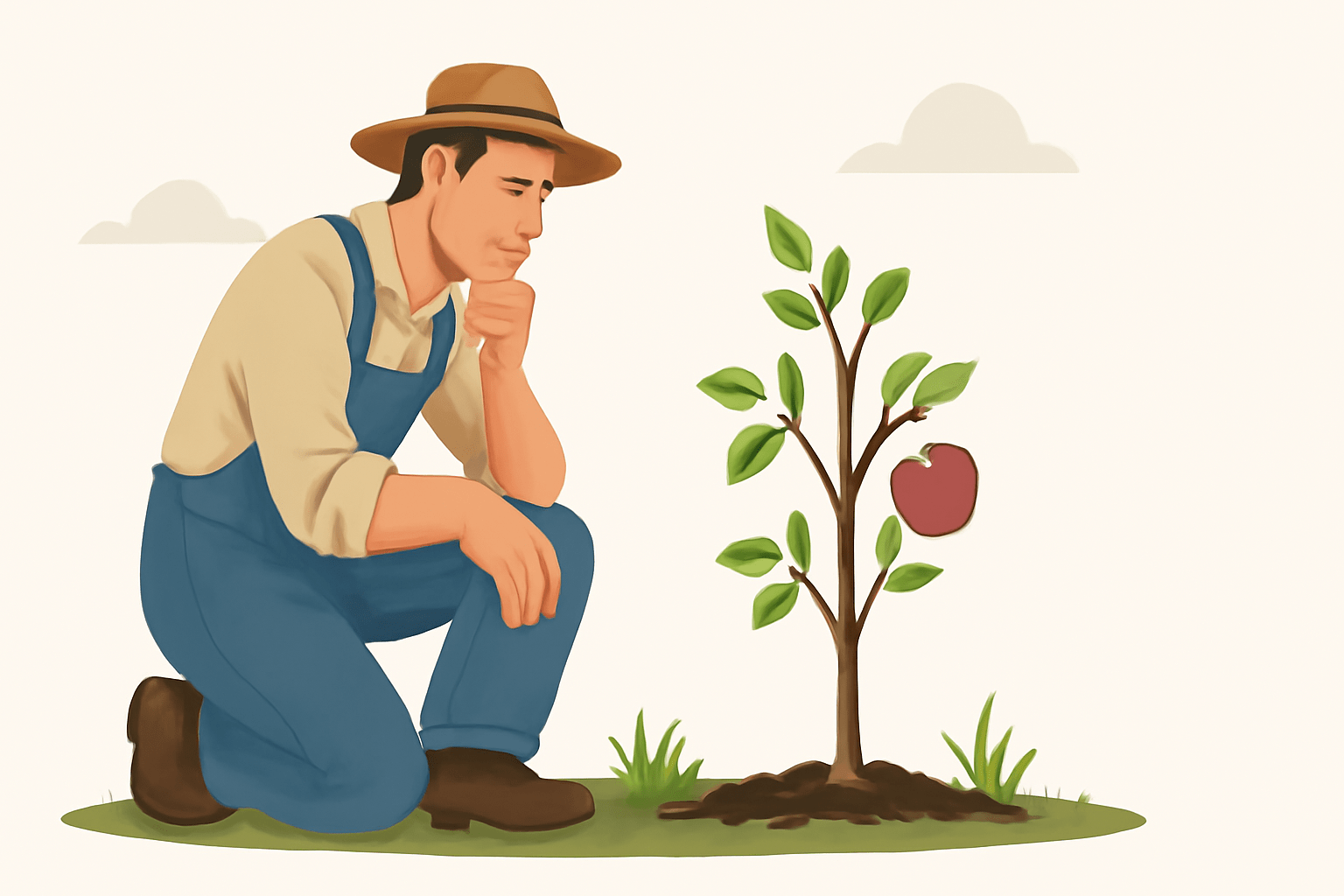
🌱 1. Slow Growth or Stunted Tree Development 🌱
If your apple tree 🌳 isn’t growing as quickly ⚡ as you’d like, several factors could be at play ⚙️.
Causes:
- Poor Soil Quality 🧪: Apple trees 🌳 require well-drained, nutrient-rich soil 🌱. Compacted or nutrient-deficient soil 🌍 can limit root development 🌱 and slow growth 🐢.
- Lack of Sunlight 🌞: Apple trees 🌳 need at least 6–8 hours of direct sunlight 🌞 each day to grow strong 💪 and produce fruit 🍏. A lack of sunlight 🌥️ can cause slow growth 🐢.
- Overwatering or Underwatering 💧: Both extremes 🚫 can stress your tree 🌳, causing it to grow slowly or even die ☠️.
Solutions:
- Improve Soil Quality 🌿: Test 🧪 the soil 🌍 and amend it with compost 🌾 or organic matter 🍂 to improve drainage 🌱 and nutrient content 🧪. If the soil 🌍 is too heavy or compacted 🌱, consider digging a larger hole 🕳️ and adding organic material 🌿.
- Provide Adequate Sunlight 🌞: Ensure your tree 🌳 is planted in a spot 🌞 with plenty of sun exposure ☀️. Trim ✂️ any nearby branches 🌿 or structures 🏢 that may be blocking sunlight ☀️.
- Watering Routine 💧: Establish a deep watering 💦 schedule. Water 💧 the tree 🌳 deeply once a week 🗓️ during dry spells 🌞, ensuring the roots 🌱 get enough moisture 💧 without becoming waterlogged 💦.
🌳 2. Non-Bearing Apple Tree (No Fruit Production) 🍏
One of the most frustrating issues 😞 for apple tree 🌳 owners is a tree 🌳 that grows well 🌿 but doesn’t produce fruit 🍏. Several factors could be behind this 🕵️♂️.
Causes:
- Lack of Pollination 🐝: Apple trees 🌳 generally need cross-pollination 🌸 from another variety 🌳 of apple tree 🌳 to produce fruit 🍏. Without proper pollination 🌸, the tree 🌳 won’t bear fruit 🍏.
- Young Tree 🌱: It may simply be too early for your tree 🌳 to bear fruit 🍏, especially if it’s a standard variety 🌳 that takes several years 🕰️ to mature.
- Improper Care 🌿: Poor soil 🌍, insufficient watering 💧, or pest damage 🐜 can also prevent fruiting 🍏.
Solutions:
- Plant a Compatible Pollinator 🐝: If you only have one apple tree 🌳, consider planting another compatible variety 🍏 nearby 🌳 to ensure good pollination 🌸.
- Be Patient ⏳: Dwarf apple trees 🌱 may start fruiting 🍏 in 3–5 years, while standard trees 🌳 take 5–7 years. If your tree 🌳 is still young 🌱, give it time 🕰️ to mature.
- Ensure Healthy Conditions 🌿: Make sure the tree 🌳 is properly watered 💧, pruned ✂️, and free from pests 🐜. Apply fertilizers 🧪 as needed to encourage fruit production 🍏.
🍂 3. Pest Infestations and Diseases 🐜🦠
Pests 🐜 and diseases 🦠 can weaken your apple tree 🌳, stunt growth 🌱, and damage the fruit 🍏. Keeping an eye 👀 out for signs of pests 🐜 or disease 🦠 is crucial 🔑.
Common Pests:
- Aphids 🐞: These tiny insects 🐜 suck sap 💧 from leaves 🍃, causing curling and yellowing.
- Apple Maggots 🐛: These pests 🐜 bore into apples 🍏, causing them to rot 🦠.
- Codling Moths 🦋: They lay eggs 🥚 in apples 🍏, and the larvae 🦠 eat the fruit 🍏 from the inside out.
Common Diseases 🍄:
- Apple Scab 🍏: A fungal disease 🍄 that causes dark, scabby spots on leaves 🍃 and fruit 🍏.
- Powdery Mildew 🍄: A fungal infection 🍄 that covers the leaves 🍃 in a white, powdery substance 🍂, stunting growth 🌱.
Solutions:
- Regular Inspections 🔍: Check 👀 your tree 🌳 regularly for signs of pests 🐜 or disease 🦠. The sooner you spot a problem 🕵️♂️, the easier it is to treat 🛠️.
- Organic Pest Control 🌿: Use natural methods 🌱 like neem oil 🌿, insecticidal soap 🧼, or diatomaceous earth 🐚 to control pests 🐜. You can also introduce beneficial insects 🦗 like ladybugs 🐞 to eat aphids 🐜.
- Fungicides for Prevention 🍂: Apply fungicides 🍄 during the growing season 🌞 to prevent diseases 🦠 like apple scab 🍏 and powdery mildew 🍄. Always follow the instructions 📜 on the label for best results.
❄️ 4. Frost Damage ❄️
Apple trees 🌳 are susceptible to frost damage 🌨️, especially during spring 🌸 when the tree 🌳 begins to flower 🌸.
Causes:
- Late Spring Frosts 🌨️: Spring frosts ❄️ can kill blossoms 🌸 and prevent fruiting 🍏.
- Sudden Temperature Drops 🌡️: A sudden drop in temperature 🌡️ during the flowering phase 🌸 can cause major damage 💔 to delicate buds 🌸 and flowers 🌸.
Solutions:
- Frost Protection ❄️: Use frost cloth 🧣 or garden blankets 🛏️ to cover the tree 🌳 during late frosts 🌨️. You can also use string lights 💡 around the tree 🌳 to generate heat 🌡️ during cold spells 🌨️.
- Plant in a Protected Area 🌿: Consider planting your apple tree 🌳 in a location 🏡 that’s less exposed to frost 🌨️, like a sheltered spot near a wall 🧱 or fence 🏚️ that can block cold winds 💨.
🌾 5. Overcrowding and Poor Spacing 🌳
Apple trees 🌳 need adequate space 🏡 to grow properly. If they’re planted too close together 🤦♂️, they may struggle to thrive 🌱.
Causes:
- Too Close to Other Trees 🌳: When apple trees 🌳 are planted too close to other trees 🌳 or structures 🏢, they may compete for light ☀️, water 💧, and nutrients 🧪, leading to weak growth 🌱.
Solutions:
- Proper Spacing 🌳: Space your apple trees 🌳 10–15 feet apart 🌱 to allow each tree 🌳 enough room to grow. Proper spacing ensures good airflow 💨, sunlight access 🌞, and better root development 🌱.
🌟 The Bottom Line 🌟
While challenges 😓 are a natural part of growing apple trees 🌳, most issues can be prevented 🚫 or solved 🛠️ with proper care 🧑🌾 and attention 👀. By addressing common problems like slow growth 🐢, non-fruiting 🍏, pest infestations 🐜, frost damage 🌨️, and overcrowding 🏡, you can help your apple tree 🌳 grow strong 💪, healthy 🌱, and productive 🍏. With a little patience 🕰️ and the right strategies 🌱, you’ll soon be enjoying a bountiful harvest 🍏 of delicious apples 🍏! 🌳
🍏🌟 Final Thoughts 🌟🍏
Growing an apple tree 🌳 is a rewarding journey 🌱 that requires patience 🕰️, care 💚, and a bit of knowledge 🧠. From understanding the growth timeline 🗓️ to overcoming common challenges 🛠️, every step you take toward nurturing your tree 🌳 contributes to a healthier, more fruitful harvest 🍏 in the future.

Remember 🧠, whether you’re planting a new tree 🌱 or tending to an established one 🌳, the key 🔑 to success lies in choosing the right variety 🍏, providing optimal care 🧑🌾, and staying vigilant 👀 against pests 🐜, diseases 🦠, and weather issues 🌦️. With time 🕰️, your apple tree 🌳 will reward you with delicious, homegrown fruit 🍏 that you can enjoy season after season 🌞.
So, embrace the process 🌱, stay patient 🕰️, and enjoy the satisfaction 😌 of watching your apple tree 🌳 grow 🌱 and thrive 🌟! Happy planting 🌿🍎!
Frequently Asked Questions (FAQ)
How long does it take for an apple tree to bear fruit?
Apple trees typically take 3–5 years to bear fruit if they are dwarf varieties, and 5–7 years for standard trees. Factors such as tree variety, climate, and care practices can influence how quickly they reach fruiting age. 🌱🍏
What is the fastest-growing apple tree variety?
Dwarf apple trees are the fastest-growing, usually reaching fruit-bearing age in 3–5 years. These trees are perfect if you want quicker results and have limited space. 🌳
Can I speed up apple tree growth?
Yes! Plant your tree in well-drained, nutrient-rich soil, ensure it gets enough sunlight, and water it properly. Regular pruning, proper fertilization, and pest control will also help promote faster growth. 🌿💧
Why is my apple tree not growing?
If your apple tree is not growing, it may be due to poor soil, inadequate sunlight, or inconsistent watering. Check that your tree is planted in a spot with at least 6–8 hours of sunlight per day and ensure the soil is well-drained and nutrient-rich. 🌞
Lorem ipsum dolor sit amet, consectetur adipiscing elit. Ut elit tellus, luctus nec ullamcorper mattis, pulvinar dapibus leo.
How often should I water my apple tree?
Apple trees should be watered deeply once a week, especially during dry periods. Ensure the soil is moist but not soggy. Overwatering can cause root rot, so always check the soil before watering. 💧
When is the best time to plant an apple tree?
The best time to plant apple trees is during early spring or fall when temperatures are moderate, and the tree has enough time to establish roots before the extreme heat or cold sets in. 🌱
Do I need two apple trees for pollination?
Most apple tree varieties need cross-pollination to produce fruit, so it’s a good idea to plant at least two compatible apple trees nearby. Bees and other pollinators will help transfer pollen between the trees. 🐝🌸
How do I protect my apple tree from frost?
To protect your apple tree from late spring frosts, use frost cloths or garden blankets to cover the blossoms. Planting your tree in a sheltered spot can also help protect it from cold winds. ❄️🌿
